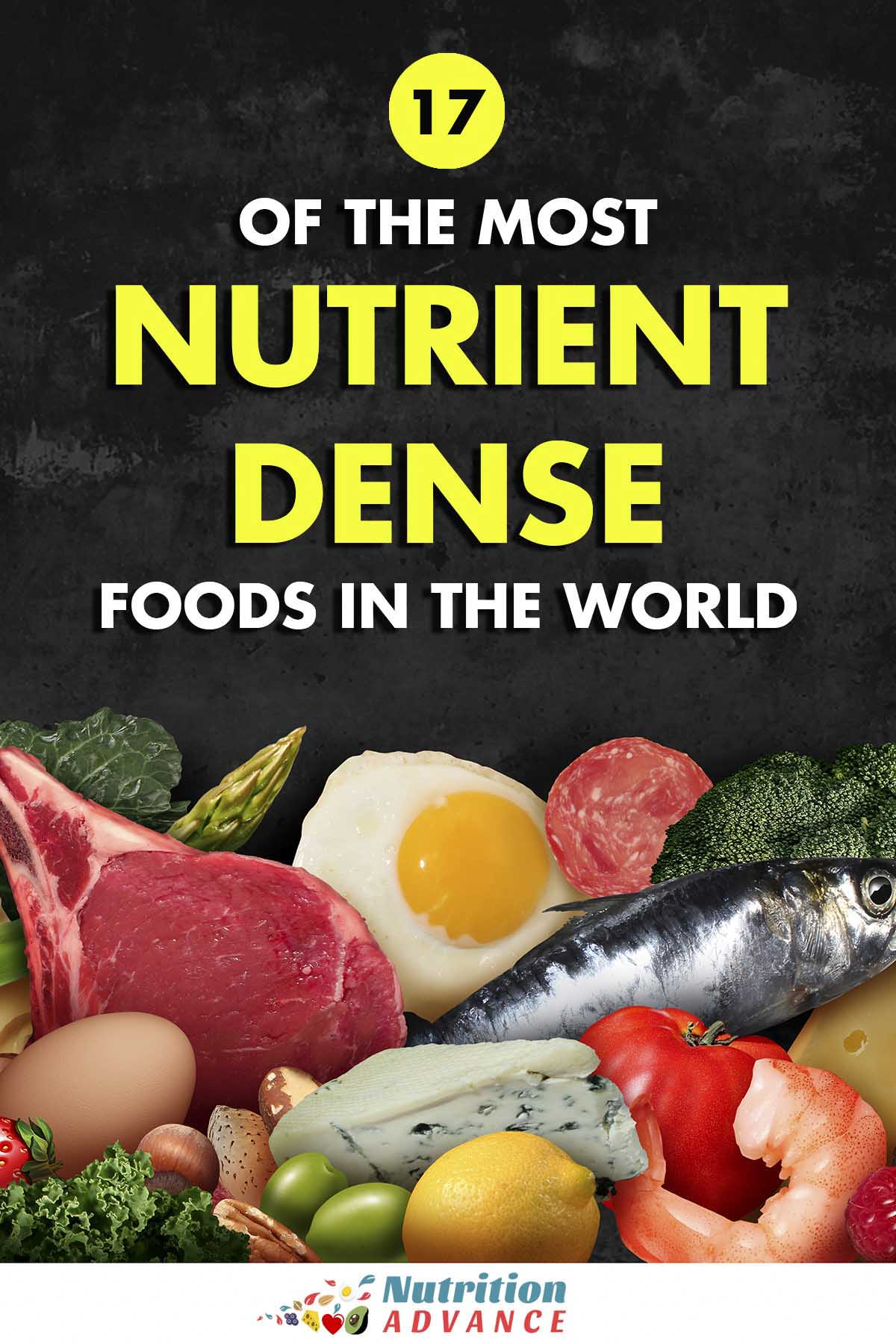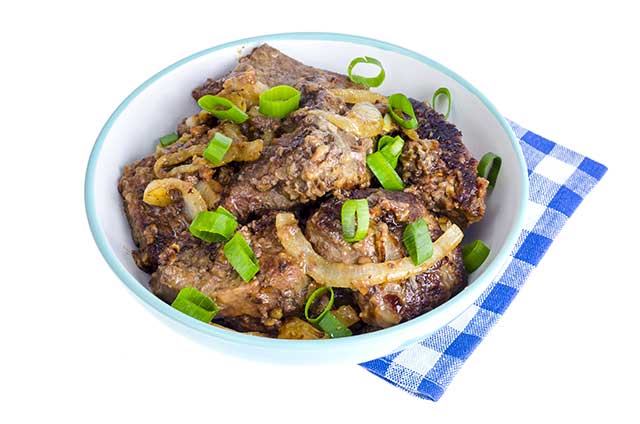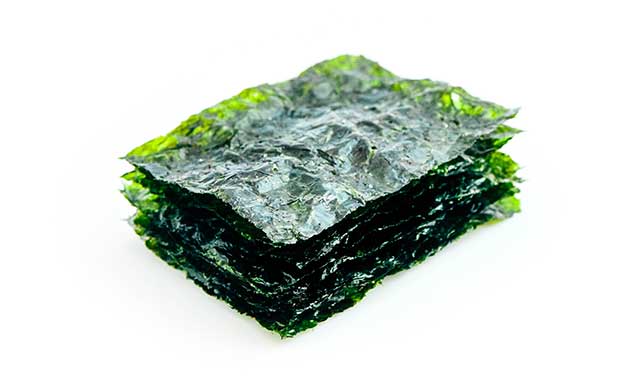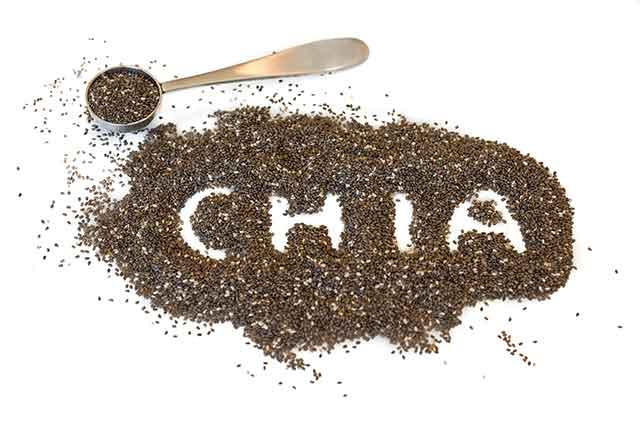There are many important nutritional topics, but focusing on nutrient density is one of the best ways to achieve a healthy diet.
This article examines some of the most nutrient-dense foods in the world.
Half of the foods listed are animal-based foods and half are plant-based, so there is something for everyone.
For each food, we list all the nutrients present at levels higher than 10% of the recommended daily value.
Unless otherwise stated, all nutritional data is courtesy of the USDA’s FoodData Central database.
1. Liver
There are many nutrition myths about “superfoods.”
However, if a so-called “superfood” truly exists, then we might have to give that recognition to liver.
Whether it’s beef, pork, lamb, or chicken liver, all are incredibly rich in protein and provide a significant range of vitamins and minerals.
The following list shows the micronutrient content of cooked beef liver per 100 grams (1):
- Vitamin B12: 1176 % DV
- Copper: 714 % DV
- Vitamin A RAE: 1049 % DV
- Riboflavin: 201 % DV
- Niacin: 88 % DV
- Pantothenic Acid: 71 % DV
- Folate: 63 % DV
- Selenium: 52 % DV
- Phosphorus: 50 % DV
- Iron: 36 % DV
- Zinc: 35 % DV
- Manganese: 18 % DV
- Potassium: 10 % DV
As can be seen, liver is loaded with nutritional value, and it is the most nutritious animal-based food.
Eating liver just once per week is enough is a great way to help ensure sufficient micronutrient intake.
Liver is also simple to make; just fry it with some onions for a quick and easy meal.
2. Eggs
Eggs are among the most nutritionally complete foods in the world.
After all, an egg contains all the nutrients for a baby chick to grow.
Here is the nutrition breakdown per 100 grams, which is approximately two large cooked eggs (2):
- Choline: 53.4 % DV
- Selenium: 44 % DV
- Riboflavin: 30.2 % DV
- Vitamin B12: 18.5 % DV
- Phosphorus: 17.2 % DV
- Vitamin A (RAE): 16.6% DV
- Pantothenic Acid: 14 % DV
- Folate: 11 % DV
Besides these vitamins and minerals, eggs are also rich in high-quality protein.
Eggs also contain a range of carotenoid compounds, with two of the most important being lutein and zeaxanthin. These compounds may potentially help protect our eyesight as we age and reduce the risks of macular degeneration (3, 4, 5).
Additionally, eggs are the most abundant dietary source of choline.
Choline is a vitamin-like compound that is crucial to our health, and it may help to protect against fatty liver disease and DNA damage (6, 7).
3. Wild Sockeye Salmon
There are many different varieties of salmon, but wild sockeye is one of the most nutritionally impressive.
Firstly, this fish contains approximately 25 grams of protein and 2.5 grams of omega-3 per 100 g.
On a per-100-gram basis, the micronutrient profile of salmon looks like this (8):
- Vitamin D: 168 % DV
- Vitamin B12: 74.5 % DV
- Selenium: 50.7 % DV
- Niacin: 50.6 % DV
- Vitamin B6: 41.4 % DV
- Phosphorus: 30.5 % DV
- Choline: 20.5 % DV
- Riboflavin: 14.5 % DV
- Pantothenic Acid: 12.7 % DV
- Potassium: 12.5 % DV
- Thiamin: 10.5 % DV
Furthermore, wild sockeye salmon is one of the lowest-mercury fish options (9, 10).
4. Oysters
Shellfish are one of the most nutritious groups of food, and oysters are arguably the best among them.
Oysters offer a good source of omega-3 fatty acids, and 100 grams provides the following vitamins and minerals (11):
- Zinc: 406.9 % DV
- Copper: 222 % DV
- Vitamin B12: 215.2 % DV
- Selenium: 43.9 % DV
- Iron: 39.8 % DV
- Manganese: 23 % DV
- Choline: 18.4 % DV
- Phosphorus: 15% DV
Despite the impressive nutrient profile, not many people eat oysters these days.
However, alongside liver, they are one of the most nutrient-dense foods available.
5. Red Meat (Beef/Lamb)
While the media changes its mind about red meat on a seemingly weekly basis, here are the known facts about it:
- Red meat is an excellent source of protein, vitamins, and minerals – especially vitamin B12, iron, and zinc (12).
- A wide range of epidemiological (observational) research links higher red meat intake with a slightly increased risk of certain cancers (13).
- Controlled trials are yet to find evidence for harm from red meat consumption (14).
Regarding the nutritional content of red meat, the following values show the nutrients provided by 100 grams of 80% lean beef (15):
- Zinc: 41.6 % DV
- Vitamin B12: 41.5% DV
- Selenium: 29 % DV
- Niacin: 23.1 % DV
- Phosphorus: 17.9 % DV
- Vitamin B6: 16.5 % DV
- Choline: 14.7 % DV
- Iron: 14.3 % DV
- Riboflavin: 10.1 % DV
Of course, beef and lamb are also an excellent source of protein, and they offer around 25 grams per 100 g.
6. Seaweed (Dried)
Most green vegetables are nutrient-dense and full of essential vitamins and minerals.
However, one of the most nutritious vegetables comes from the sea: seaweed.
All seaweed is an excellent source of nutrition, but dried seaweed is more nutrient-dense due to the lower water content.
Seaweed is also the most significant dietary source of iodine, which is an essential mineral that plays a crucial role in thyroid health (16).
Using data from the NCC Nutrient Database, here are the nutrient values per 100 grams of dried seaweed nori sheets:
- Iodine: 2460 % DV
- Vitamin B2: 458.3 % DV
- Manganese: 300 % DV
- Vitamin A RAE: 176.3 % DV
- Iron: 108.9 % DV
- Potassium: 81.1 % DV
- Copper: 80.0 % DV
- Riboflavin: 78.8 % DV
- Calcium: 43 % DV
- Phosphorus: 35.0 % DV
- Sodium: 32.9 % DV
- Vitamin K1: 30.5 % DV
- Vitamin E: 30.3 % DV
- Niacin: 27.5 % DV
- Vitamin C: 23.3 % DV
- Thiamin: 16.0 % DV
- Folate: 15.3 % DV
Despite the impressive nutrient profile, it is worth remembering that dried seaweed is very light. In other words; consuming 100 grams of dried nori sheets would be unrealistic.
However, even small amounts provide a wide range of nutrients – particularly iodine.
Another good reason to include seaweed is that it contains some unique phytonutrients. These compounds include fucoidan and fucoxanthin, and initial research suggests they might offer health benefits (17, 18, 19, 20).
7. Hemp Seeds
Hemp seeds are the seeds of the Cannabis sativa plant, and they’re full of essential nutrients.
The seeds have a somewhat nutty taste, and they can be consumed as a snack or used in cooking.
Per 100 grams, hemp seeds offer the following nutrition profile (21):
- Manganese: 380 % DV
- Magnesium: 175 % DV
- Phosphorus: 165 % DV
- Thiamin: 85 % DV
- Copper: 80 % DV
- Zinc: 66 % DV
- Niacin: 46 % DV
- Iron: 44.2 % DV
- Selenium: 36.9 % DV
- Potassium: 34.3 % DV
- Vitamin B6: 30 % DV
- Folate: 27.5 % DV
- Riboflavin: 16.8 % DV
- Choline: 14.5 % DV
- Pantothenic acid: 10 % DV
In addition to these vitamins and minerals, hemp seeds are also rich in ALA omega-3 fatty acids, fiber, and protein.
8. Sardines
Back at sea once more, sardines are another nutrient-dense fish.
They are full of omega-3 fatty acids, protein, and a variety of vitamins and minerals.
Additionally, since we generally eat the whole fish when we eat sardines, including bones, these little fish are also an excellent source of calcium.
Here are the nutrients they contain per 100g (22):
- Vitamin B12: 149 % DV
- Selenium: 75.3 % DV
- Phosphorus: 49 % DV
- Vitamin D: 48.3 % DV
- Calcium: 38.2 % DV
- Niacin: 26.2 % DV
- Iron: 16.2 % DV
- Choline: 13.6 % DV
- Riboflavin: 13.4 % DV
- Sodium: 12.8 % DV
- Potassium: 11.3 % DV
- Vitamin E: 10.1 % DV
Sardines also provide 25 grams of protein and almost two grams of omega-3 per 100 grams, making them one of the most nutritious seafood choices.
9. Shiitake Mushrooms (Dried)
Shiitake mushrooms have become a lot more popular in the Western world recently, and it isn’t difficult to see why.
For one thing, these mushrooms taste delicious, and they are also an excellent source of nutrition.
Shiitake mushrooms have long been part of the Japanese and other East Asian diets, and they offer a meaty flavor and a chewy texture.
While fresh and dried shiitake mushrooms are both excellent choices, mushrooms dried in the sun offer the most nutrients per gram.
Here are the nutrients in 100 grams of dried shiitake mushrooms (23):
- Copper: 258% DV
- Pantothenic acid: 218.8 % DV
- Riboflavin: 74.7 % DV
- Niacin: 70.5 % DV
- Selenium: 65.9 % DV
- Manganese: 58.8 % DV
- Vitamin B6: 48.3 % DV
- Potassium: 43.8 % DV
- Folate: 40.8 % DV
- Vitamin: 38.5 % DV
- Choline: 36.7 % DV
- Magnesium: 33.3 % DV
- Phosphorus: 29.4 % DV
- Thiamin: 20 % DV
Furthermore, there is some promising initial research on the potential anti-inflammatory effects of several compounds within mushrooms (24, 25, 26, 27).
To use dried shiitake mushrooms, we simply need to soak them in water for an hour or two before cooking.
10. Almonds
Almonds are among the most nutritious of the various nuts, and they’re an excellent source of the hard-to-find vitamin E.
These nuts are full of healthy fats, protein, an assortment of micronutrients, and most of the carbohydrate is from fiber.
Per 100 grams, almonds offer the following vitamins and minerals (28):
- Vitamin E: 127.3 % DV
- Manganese: 109 % DV
- Magnesium: 67.5 % DV
- Riboflavin: 66.9 % DV
- Copper: 51.6 % DV
- Phosphorus: 48.1 % DV
- Calcium: 26.9 % DV
- Potassium: 20.9 % DV
- Zinc: 20.8 % DV
- Iron: 20.6 % DV
- Niacin: 18.1 % DV
- Thiamin: 13.7 % DV
- Folate: 11 % DV
Just a handful (1 ounce/28 grams) in a day is a great way to get a wide range of micronutrients.
11. Mackerel (Atlantic)
Mackerel is a nutrient-dense, oily fish that offers a good source of omega-3, protein, vitamins, and minerals.
This fish is also very low in mercury providing it is the Atlantic mackerel variety. Other types of mackerel, such as King mackerel and Spanish mackerel, can be relatively high in mercury (29).
Per 100 grams, the nutrient profile of Atlantic mackerel is as follows (30):
- Vitamin B12: 316.7 % DV
- Vitamin D: 115.4 % DV
- Selenium: 73.7 % DV
- Niacin:34.3 % DV
- Phosphorus: 27.8 % DV
- Magnesium: 24.3 % DV
- Riboflavin: 24.2 % DV
- Vitamin B6: 23 % DV
- Choline: 11.7 % DV
- Potassium: 11.5 % DV
- Thiamin: 10.6 % DV
Whether pan-fried, grilled, or steamed, mackerel is a tasty and nutrient-rich addition to any diet.
12. Chia Seeds
Most seeds are a rich source of vitamins and minerals, and chia seeds are no exception.
However, one of the best things about chia is their omega-3 content.
Per 100 grams, chia seeds offer around 18 grams of omega-3 (31).
This omega-3 is in the form of alpha-linolenic acid (ALA), which is not as bioavailable as DHA and EPA from seafood (32).
Despite this, with such an ample provision, chia seeds can still contribute a large amount of omega-3 to the average diet.
Per 100 grams of chia seeds, we can obtain the following nutrients (31):
- Vitamin K1: 886.1 % DV
- Manganese: 136.2 % DV
- Magnesium: 97.5 % DV
- Iron: 91.1 % DV
- Phosphorus: 86 % DV
- Selenium: 78.9 % DV
- Vitamin B6: 69.7 % DV
- Calcium: 63.1 % DV
- Copper: 46.2 % DV
- Niacin: 30.7 % DV
- Zinc: 30.5 % DV
- Folate: 12.3 % DV
- Thiamin: 12 % DV
- Choline: 11.9 % DV
- Potassium: 11.6 % DV
Chia seeds can either be eaten alone or added to smoothies, yogurts, cereals or salads.
13. Mussels
As previously mentioned, shellfish are one of the most nutrient-dense types of food.
In addition to oysters, mussels are another nutrient-rich choice.
Mussels provide close to 25 grams of protein, almost one gram of omega-3 fatty acids, and a good range of micronutrients.
Here are some of the most concentrated vitamins and minerals in mussels (32):
- Vitamin B12: 400 % DV
- Manganese: 340 % DV
- Selenium: 128 % DV
- Iron: 37.3 % DV
- Phosphorus: 28.5 % DV
- Riboflavin: 24.7 % DV
- Vitamin C: 22.7 % DV
- Thiamin: 20 % DV
- Folate: 19 % DV
- Zinc: 17.8 % DV
- Sodium: 15.4 % DV
- Niacin: 15 % DV
- Choline: 11.8 % DV
14. Pumpkin Seeds
Pumpkin seeds are one of the best dietary sources of magnesium.
These seeds also contain a good range of vitamins, minerals, protein, and fiber.
On a per-100-gram basis, here are some of the most significant nutrients in pumpkin seeds (33):
- Manganese: 224.5 % DV
- Magnesium: 137.5 % DV
- Phosphorus: 117.4 % DV
- Copper: 63.8 % DV
- Zinc: 50.9 % DV
- Iron: 44.8 % DV
- Potassium: 22.5 % DV
- Niacin: 22.2 % DV
- Folate: 14.3 % DV
- Selenium: 13.4 % DV
- Choline: 11.5 % DV
15. Herring
Herring is another common variety of oily fish, and it offers more than two grams of omega-3 per 100 grams (34).
Additionally, herring is one of the cleanest types of seafood, and it has very low levels of heavy metal contamination (29).
Herring supplies around 23 grams of protein per 100 grams as well as the following nutrients (34):
- Vitamin B12: 219 % DV
- Selenium: 66.9 % DV
- Vitamin D: 53.5 % DV
- Phosphorus: 30.3 % DV
- Niacin: 20.6 % DV
- Riboflavin: 17.6 % DV
- Choline: 15.1 % DV
- Potassium: 12 % DV
- Magnesium: 10.3 % DV
16. Brazil Nuts
Brazil nuts are the single best source of selenium in the world.
On this note, just one nut provides more than 100% of the daily value for selenium. Regularly eating much more than this can even be a risk for selenium toxicity (35, 36).
These nuts are also an excellent source of copper, magnesium, phosphorus, and fiber.
Per 100 grams, brazil nuts provide large concentrations of these vitamins and minerals (37):
- Selenium: 2738.6 % DV
- Magnesium: 94 % DV
- Copper: 87.2 % DV
- Phosphorus: 72.5 % DV
- Manganese: 61.2 % DV
- Thiamin: 41.1 % DV
- Vitamin E: 28.1 % DV
- Potassium: 18.8 % DV
- Calcium: 16 % DV
- Iron: 13.5 % DV
17. Beef Jerky
It may sound strange to hear that beef jerky is nutrient-dense.
However, the drying out process removes the moisture (water content) and concentrates the existing nutrients.
That said, there is a wide range of jerky available, and it is better to opt for minimally processed options.
While some types of jerky will contain an assortment of ingredients, the best quality choices usually include just beef and some seasonings.
The overall nutrition profile can vary significantly between brands, but it will be similar to regular beef except with higher concentrations of each nutrient.
18. Wheat Germ
Does wheat belong in a nutrient density list?
If you are thinking of bread rolls, baguettes, and sliced bread, then no, it probably doesn’t.
However, 100 % wheat germ is surprisingly rich in nutrients, and just 100 grams provides more than the recommended daily value for several vitamins and minerals.
Per 100 grams, wheat germ offers large amounts of the following nutrients (38):
- Manganese: 665.1 % DV
- Thiamin: 125.5 % DV
- Selenium: 113.1 % DV
- Vitamin E: 108.3 % DV
- Phosphorus: 84.2 % DV
- Zinc: 81.9 % DV
- Folate: 70.3 % DV
- Vitamin B6: 65 % DV
- Magnesium: 59.8 % DV
- Copper: 39.8 % DV
- Iron: 34.8 % DV
- Niacin: 34.1 % DV
- Riboflavin: 29.4 % DV
- Choline: 26.0 % DV
- Potassium: 25.5 % DV
- Pantothenic acid: 22.6 % DV
- Vitamin K1: 12.4 % DV
Final Thoughts
While many of us learn that apples and oranges are nutritious choices, the very most nutrient-dense foods tend to come from meat, seafood, nuts, and seeds.
No matter what diet someone follows, adding some of the above-listed foods can add a lot of essential nutrients to the average diet.
For more nutritious foods, see this list of 99 healthy snacks.





Vitamin K2 is an important nutrient in many of these foods, but you have missed it.
Granted, you cite K1, but it appears that K2 is very important to human health.
Hi Micki,
You are right that vitamin K2 appears to be an important nutrient. However, the menaquinone (K2) content of food is difficult to source and it is rarely published in nutritional databases. Additionally, no recommended intake levels have been set, unfortunately.
However, you can find twenty foods high in K2 here: https://www.nutritionadvance.com/foods-high-in-vitamin-k2/